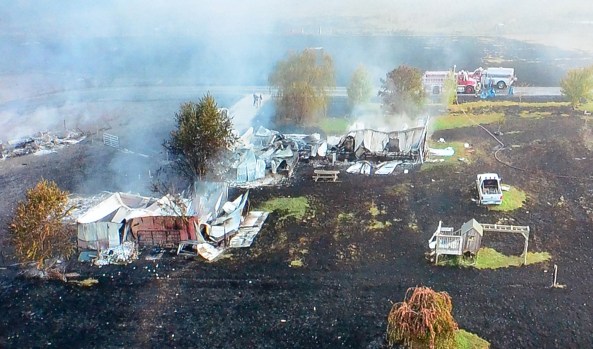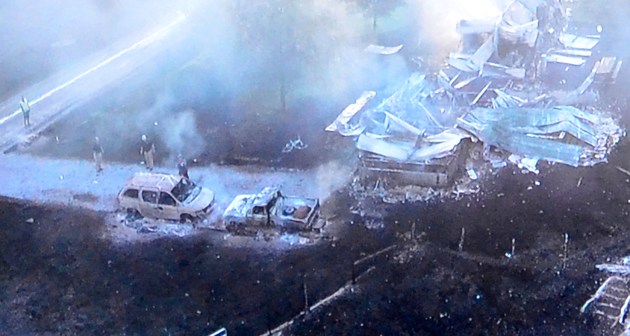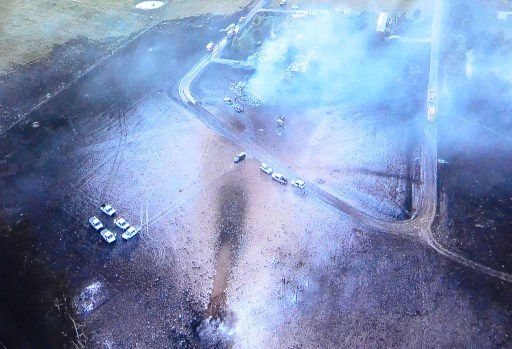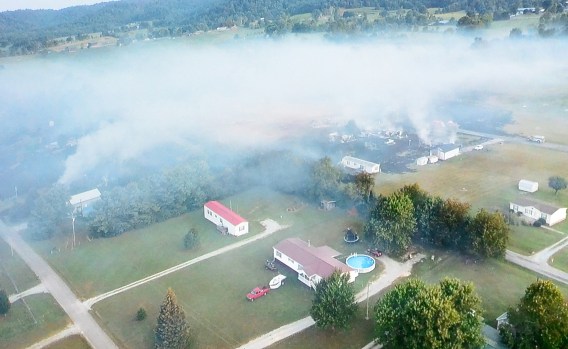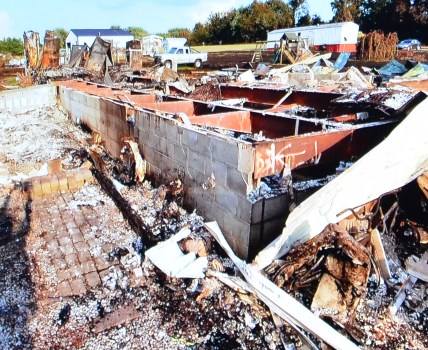First responders examine lessons learned from explosion
Published 11:38 am Thursday, August 22, 2019
|
Getting your Trinity Audio player ready...
|
STANFORD — “All Lincoln County firefighters. All Lincoln County firefighters. We’ve had some type of big explosion in the Moreland area … Whole Junction City is lit up … Notify railroad to not let any trains come through … Looks like it’s probably shooting 100-150 feet in the air … I want everybody from the train tracks to 127 evacuated … It appears I have three structures have already burned. Three have already burned and I have approximately five acres of land on fire at this time.”
Those were some of the first communications from responders in the first one to two minutes following the explosion of Enbridge’s Texas Eastern pipeline in the Indian Camp Subdivision in Moreland in the early morning hours of Aug. 1 as the phone lines lit up at the Bluegrass 911 Communications Center.
On Thursday, Aug. 15, two weeks following the disaster, Bluegrass 911 dispatchers and directors and some of the responder agencies who were on scene after the explosion gathered at the Emergency Operations Center in Stanford to discuss the disaster situation.
Donnie Gilliam, director of Lincoln County Emergency Management, who became the source of information for the many media outlets covering the event, presided over the meeting.
“I’m very proud of everybody’s response, the job they did,” he said. “There were some mistakes made. We’re not going to dwell on them because that happens. We learn from them. It’s called experience. Nobody that responded died and that’s a good thing. We did have a citizen that perished in this event. It’s unfortunate and, to be honest with you, I am amazed that there weren’t more. We had six injuries and one death and it could have been 70-80 just as easy.”
“Of course nobody expected this. Nobody wanted it. And if it ever happens again it will be too soon. But this is why we train. This is why we do this crazy stuff that we figure probably will never happen because, daggone, one day you get woke up and it’s happened.”
The explosion of the 30-inch gas transmission pipeline, which happened at approximately 1:20 a.m. on Aug.1 and killed one person, blasted a 13-foot deep, 36-foot-long crater in the ground, blew a 29-foot piece of pipe over 500 yards away and shot intense flames about 300 feet into the air.
Lisa Denise Derringer, 58, was the person who died at the scene. Gilliam said it was believed that she left her home after the explosion and was overwhelmed by the extreme heat. Lincoln County Coroner Farris Marcum said that he has not received the final report from her autopsy but that she had “thermal injuries.”
The rupture caused a tremendous amount of damage over an area of 30 to 40 acres, according to Trish O’Quin, EMS deputy director. The blast destroyed and damaged several homes, vehicles and property and damaged the tracks of Norfolk Southern Railroad. Firefighters were still working to douse the flames hours later.
O’Quin presented a video to show what happened on scene the day of the explosion, using photos and drone footage taken by different responder agencies to show the devastation left by the blast. The video opened with the audio of the first 911 calls.
“There were five residences that were totally destroyed and those were residences that would have been within a few hundred feet of the blast site,” Gilliam said as the first picture flashed on the screen. “As you got further out, we had about 17 more houses that were damaged. There wasn’t any in between. They were either destroyed or moderate damage. That means usually siding was affected, maybe some roof. About 30 acres or maybe a little more than that was scorched.”
Gilliam said it was hard to explain just how intense the heat was that morning.
“The blacktop highway around there is pretty much just gravel. The fire melted and consumed the tar,” he said. “I don’t know how hot it was, but we were a mile to a 1-½ away and we could feel the heat.”
As he talked of the heat, O’Quin pointed to a photo of vehicles parked in a driveway that had melted, with the melted metal puddled beneath the vehicle.
“I’m just truly amazed that responders were able to get down in there. I’m even more amazed that anybody got out alive,” Gilliam said.
There was also a stark contrast obvious in one drone photo. As the drone rose over a destroyed home, several feet away stood a play area on a small patch of green grass.
“The play area was surrounded by burning destruction and it didn’t get touched,” said O’Quin. “You could still go out and play on the jungle gym.”
Two Blasts
While most talk was about the explosion, Gilliam said that it wasn’t the first that morning.
“There were actually two blasts,” he said. “There was the initial blast where it consumed the oxygen and then, as it built oxygen up … About eight seconds later there was another blast, and that was when it was actually the ignition that took off. And that’s when you start worrying about, ‘Well, is that it? Is there going to be another one on down the line or on up past?’”
Following the explosion, calls went out across the region with reports of fires everywhere, including Perryville, Harrodsburg Road, Somerset.
“We were out looking for fires,” Somerset-Pulaski County SRT/Haz-Mat 12 Chief Doug Baker said. “Pulaski County sent three or four fire departments out looking for the fire initially.”
How long to shut off the gas?
When asked how long it took to shut off the gas, Gilliam said it took about 50 minutes from the time a drop in pressure was noticed in the pipeline.
“They have a person at the compressor plant but you have to cut it off at the plant and then also at the pipeline so there had to be a guy come get the equipment and go to the pipeline,” he said. “One of our goals is to try and get that time down. But obviously not knowing where, … you’ve got 9.000 miles of pipeline so it’s not to just say, ‘Well, he should have been ready to respond.’”
“There’s not just one button that you can push and everything stops,” added O’Quin.
Gilliam said at first it was uncertain whether the trouble started with the pipeline system.
“In the beginning we weren’t sure,” he said. “We didn’t know if it was the pipeline or if something else had caused it.”
Candy Wilson, Bluegrass 911 assistant director, said they received a lot of different reports, “We were getting reports of airplanes falling from the sky, trains on fire …”
Jim McGuffey, Enbridge incident commander, said they couldn’t tell exactly where the explosion happened.
“At the plant we can tell what line it’s on, but not really what mile post it’s at. In this situation, we saw it wasn’t far out and we dispatched people,” he said.
What was the ignition source?
Two weeks following the explosion, there is still no answer as to what ignited the blast.
“It could be a lot of different things,” said Gilliam. “Generally, in a situation like that, it’s metal on metal, metal on rocks or rocks on rocks. Once that air/oxygen to gas saturation point is reached, flashpoint is reached, it doesn’t take much to set it off. It’s just a spark. I don’t think anybody went out and started their car or was smoking or anything like that. It was just part of the blast.”
When asked if the cause could have been static electricity, Gilliam answered, “It could have been. We just don’t know.”
Heroic efforts
When Boyle County Sheriff’s Deputies Chris Stratton and Donnie Moses got to the scene, it was too late to save Derringer’s life but Marcum said the two were able to remove her body from the burning area.
Lincoln County Sheriff’s Special Deputy Colby Reik was able to save lives that morning, rescuing an elderly couple from their burning home.
“This young man is a genuine hero,” Gilliam said. “He had no business being where he was, and he knew that. As he was driving through, he saw an elderly man on the steps coming out of his trailer with a flashlight and he stopped and he grabbed him and took him to his car. The guy’s screaming at him the whole time but the noise was so loud he couldn’t hear. And what he was screaming was, ‘My wife! My wife!’ Colby finally realized what he was screaming, ran back to the trailer.”
“We’ve got it on video, this place is burning on fire and he sees her through the door, runs in, grabs her and carries her out and puts her in the car. He saved those people’s lives at the risk of his own.”
Communication can sometimes be a problem in rescue efforts and Gilliam said Reik’s situation was a prime example.
“Not only are your responders having to deal with extreme heat, smoke, fire, dust, but also noise. They can’t talk to each other, can’t hear your radio. Communication is always a problem and then you have something like this where your communication is working perfectly, you just can’t hear it. And he didn’t hear him.”
While Gilliam couldn’t describe how the heat of the fire felt, Reik could.
“He said it felt like a hundred hornets stinging him. He couldn’t even blink his eyes because of the heat they were so dry. He said, ‘I’ve gone too far. I shouldn’t have been there.’ He knows it,” Gilliam said. “Strategically, he made a lot of mistakes and I’m sure glad he did, but we don’t train that.”
As investigators listened to Reik’s ordeal, Gilliam said the “hair was standing up on my neck.”
“The room was full of seasoned investigators and we were all crying,” he said. “It’s hard for me to even talk about it.”
Gilliam said that Reik, who was shot twice in 2017 during a fatal gunfire exchange, said at the end of the meeting, “I think God puts us in those situations, but he’s wearing me out.”
But Reik wasn’t the only hero following the explosion.
“I’m sure there were many other heroes that day,” said Gilliam. “The fire department going in there and knocking on doors and kicking in doors and getting people out of there. I’m just amazed. It’s miraculous that anybody got out alive, and dang near everybody did.”
“The citizen’s themselves were heroes,” added O’Quin, who spoke of a lady who got her five kids out safely.
And some heroic efforts came in a safe area, as victims gathered at a temporary shelter set up at the New Hope Baptist Church in Moreland. Sandy Higgins, a volunteer with the American Red Cross, related a story of a lost dog returned to a heartbroken explosion victim.
“When (woman) first came to the reception shelter, she was extremely distraught. You could just feel her heart tearing apart because of her dog,” she said. “The dog had been rescued by a neighbor but they couldn’t find the neighbor so therefore they couldn’t find the dog.”
But help was on the way.
“There was a young man trying to hunt everything down and he found the dog,” Higgins continued. “When he came in with that dog, that woman changed. Her face totally changed from how distraught she was to how thrilled she was to see that dog. An hour later, she was still just beaming. It’s those little pieces of goodness and happiness in the world that helps you with all the bad that’s going on.”
A Moreland citizen speaks
Sandra Allen was the lone Moreland resident attending Thursday’s meeting and she often spoke through tears as she talked of the explosion and all that followed.
“I want to thank everybody. I can’t imagine what that was like to respond to that. I know you train for it,” she said. “I grew up with firefighters. I was a junior firefighter when I was in high school, but this level of this response I can’t imagine. I appreciate that …”
As she wiped tears away, Allen talked of the minutes immediately following the blast, saying it was the not knowing that was the most terrifying.
“As a citizen a few miles away… I woke up immediately,” she said. “My neighbors, after we all talked, we all thought is this the end of the world? It was that kind of a fire in the middle of the night and there was no way to know what was going on and I know you all didn’t know right away. I hope it never happens again. I hope and pray that every single day, all day.”
“I appreciate all that you did but if there’s anyway if anything ever happens again to just you radio someone on the side because 911 was unreachable,” Allen continued. “My first response was everything’s on facebook so immediately I just posted, ‘What’s going on in Moreland?’ I’m getting all kinds of things. My cousin is a conductor for Norfolk Southern and their dispatch actually told them it was a plane crash. Just because he said that’s what it was, my gut told me it was something else.”
But Allen wasn’t sure whether to stay or go.
“I didn’t know. Do I go? Is it spreading? Is it safe to stay? I didn’t stay. I didn’t know if there was something chemical on the train tracks if it was over there. I didn’t know if it was a hazmat situation when a pipeline did burn. So I ran to my car and my instinct was just to go,” she said. “On the way down I met so many responders coming up north 127. I just cried the whole way.”
After she got to looking at maps over the following days which showed all the pipelines in the area, Allen said, ‘Everywhere you go they are there. I don’t think a lot of us in the community knew that these pipelines were there and there’s three of them … Maybe I should have known, but I didn’t.”
“Just to know that there’s three of them now. I know that the media is bad for a lot of things but I’m glad that pressure is there and that Enbridge will make sure they do what they have to do to see that this doesn’t happen again,” she said.
Gilliam reminded the room that there are two other pipeline networks in the area, saying he thought they were Atmos Columbia and Kinder Morgan. “It’s not just Enbridge.”
“It’s necessary to have the pipelines,” said Gilliam. “It’s like prisons. You know we’ve got to have them but nobody wants them next door. We have made recommendations through the investigation that has been done, not only to Enbridge but to other agencies. One of those suggestions will be to try to do a better job of informing the public, the citizens. They do a great job with responders and I’m not going to say they don’t do a great job with citizens, I’ve just never been on that end of it.”
In a normal disaster, Bluegrass 911 and Emergency Management communicate with facebook and webpages and their all-call system but Gilliam said that just wasn’t possible immediately after the explosion.
“We generally get the word out on what’s going on and what you need to do and if you do need to worry. But we were just overwhelmed,” he said. “You didn’t want to go in and say there’d been a plane crash. We didn’t know that. We knew there’d been a pipeline rupture but we didn’t know what caused it. And we still don’t. That’s part of the investigation that is ongoing.”
“We didn’t have enough information to start out with,” O’Quin interjected. “Our first thought wasn’t to get on facebook because we’ve got all this going on, people coming in Unfortunately, our guy who usually handles our social media was the first guy you hear on there as a firefighter so he couldn’t get onto social media either.”
“I understand that but just not knowing it was the pipeline for so long …,” Allen said. “It was probably about a good hour into it when my dad saw it on the news. That was kind of disappointing. I know you guys have stuff going on. If somebody somewhere could get on there and let us know.”
Gilliam said that is one of the areas they saw need for improvement.
“That’s one of the recommendations we will make. We need someone. I don’t need to be the guy out here trying to manage the incident and also the guy out here talking to the media. I can’t do it, not in a situation like this,” he said. “A lot of our help are responders from other agencies. We need someone who could do nothing but facebook.”
Allen said “I would volunteer for anything like that if there’s anything I could do” to which Gilliam responded, “Well, you’ve taken the first step.”
Explosion site still closed
Gilliam said that people that live in the area have been allowed to return to their homes “if their house is livable,” but that the site is still closed.
“Only people that need to be there are allowed in,” O’Quin said. “It’s still a secured area checkpoint. There’s no sight-seeing. You have to have a reason to be there.”
Security detail will be on site for four to six weeks to safeguard property and people.
Enbridge seeing to victims’ needs
“Enbridge has been committed to the victims of this event,” said Gilliam. “But as I told one of their representatives, ‘You can throw all the money in the world at them. It’s not going to keep them from waking up in the middle of the night because of the horrific tragedy they’ve been through.’ It’s terrifying and I hope it never happens to any of you all. I appreciate and was impressed with the way everyone conducted themselves and came together for this tragic event.”
“Enbridge and the Red Cross have people assigned to each one of these families. I think Enbridge has kind of taken the lead on that and actually asked the Red Cross to step aside and let them do it. Red Cross has been there and done a lot of its role.
Enbridge is committed to taking care of these folks. As I said earlier, you can’t give peace of mind back to them but it helps knowing that you don’t have to worry about some bills and where you’re going to live. You’ll worry about it but at least it makes it a little easier.”
Gilliam said the morning of the explosion Enbridge officials loaded up gift cards to hand out to victims and provided temporary housing. The families still displaced are being housed in a local motel and despite, rumor to the contrary, they are not being forced out of those temporary confines.
“I heard on the radio that a family that was affected by the blast was going to lose its motel and I knew that was wrong,” said Gilliam. “I called my contact at Enbridge and they said, ‘Absolutely not! We cannot book rooms indefinitely because the motel won’t do that.’ You have to renew it. It was just a misunderstanding, a miscommunication, and we got it worked out.”
“Their needs are being met. People are having anxiety over where they are going to be living. They have to actually find a place to live. Where’s that going to be? What county is that going to be? Enbridge has a team assigned to these folks, trying to meet their needs. You can take that anyway you want that, but I appreciate their commitment to that.”
Gilliam said that all donations to victims of the explosion have been forward to Helping Hands Family Resource Center, which is located behind Hustonville Elementary School. Donations designated for the explosion victims will be sent to them, including money.
Enbridge hasn’t limited its victim support to just necessary needs. There have been some lighter moments where the company has helped.
“Yesterday (Wednesday) I had to pick up I don’t know how many dozen hot dogs because the kids at (undisclosed location) wanted to have a pool party before school,” McGuffey said.
Helping hands
Enbridge and the Red Cross have had crisis intervention teams on sight since the explosion.
“I’ve been very pleased with the way everything has been handled. I hope it never happens again and I don’t want us to have to do this again. But it’s something that, actually when we train, we think it’s never going to happen. To see everybody to come together and do their jobs,” Gilliam said. “This goes unnoticed but it’s important. When you’ve got people that you don’t work with every day, that you don’t train with like Doug Baker, Jim McGuffey … When you’re tugging your hair out and everything else and they show up on the scene, it means a lot to see those folks there. You know why they’re there and you know they’re going to do their job That’s a big stress release right there. You don’t have to worry about them. We had so many agencies responded without being asked.”
“That’s why we do the training,” O’Quin said. “They knew we needed them and they were coming.”
McGuffey added that he was impressed with all the agencies that showed up and how they were working together to do their jobs.
Mike Wilder, director of Danville/Boyle County Emergency Management, was one of the first on the scene.
“We were all responding as to something in Boyle County. They thought they were responding to a plane crash in Junction City … after all there is an airport there,” he said. “But as soon as I pulled out on the road … those of us who were around when the Garrard County pipeline explosion (1986) happened, I saw the same thing that night. I radioed and said this is not a plane crash. This is a gas line explosion.”
“Coming and working together. All of these guys and all of the coordinating that was done with all these agencies – that’s what emergency management is and does. I thought we, and Donnie especially, handled that as well as it could possibly be done. It was chaotic. I don’t care, you can train, you can have all the exercises every month, but the first 30 minutes or 45 minutes of any sizable disaster is going to be chaotic. We got together and we saw the plan and it worked out. Everybody did what they were supposed to do. It was a pleasure under the circumstances to come over and assist.”
Doug Baker of the Somerset/Pulaski County SRT/Haz-Mat 12 said he had never seen devastation or teamwork like he saw in Moreland.
“I’ve been doing it for 34 years now and what I saw when I come over that hill that morning was the most destruction I’ve ever seen in my career. Never seen anything like it,” he said. “I also saw the teamwork that was there. The teamwork with the fire departments, Emergency Management, the Red Cross. It all worked. I’ve worked with companies all over the state and all over the nation. Usually when we pull up on a scene like that they are there trying to get us to do whatever, Your people (Enbridge) were wonderful with us. Stayed back out of the way. I appreciate the company stepping up. I don’t usually see this.”
McGuffey, who resides in Lincoln County, thanked Baker for his statement.
“A lot of our people here (plant) are Lincoln Countians who grew up here or grew up in Boyle County and we sure don’t want our neighbors going through this,” he said. “I feel for the people. We didn’t want it to happen.”




